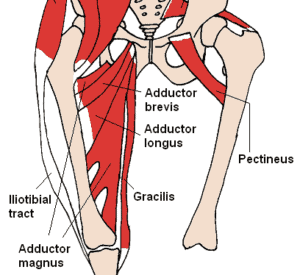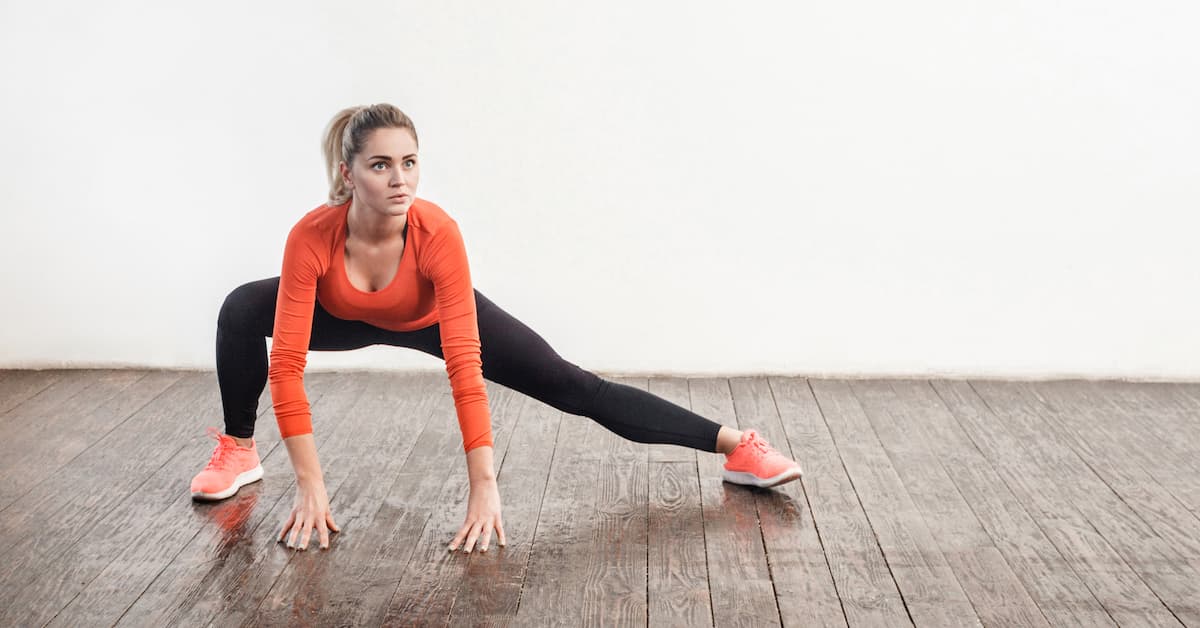The adductor muscles, located on the inner thighs, play a crucial role in hip stabilization and can lead to imbalances and discomfort when tight.
In this article, we’ll guide you through 12 effective adductor stretches that cater to various fitness levels, from beginners to more advanced individuals. Incorporating these carefully-selected stretches into your routine can enhance your flexibility, reduce muscle tightness, and ultimately improve your quality of life.
I. Understanding your adductors

The adductor muscles are a group of muscles located on the inner thigh. They consist of the adductor magnus, adductor longus, adductor brevis, gracilis, and pectineus muscles. These muscles work together to pull the legs toward the midline of the body, a movement known as adduction. Adductors play a crucial role in stabilizing the hip joint and maintaining balance during everyday activities like walking, running, and jumping.
Tight adductor muscles can lead to imbalances, restricted mobility, and pain in the hips, lower back, and knees. Regular stretching of the adductors can help improve flexibility, reduce the risk of injury, and enhance overall mobility.
II. Preparing for Adductor Stretches
This section will discuss the importance of preparing your body before performing adductor stretches.
A. Warming up
Warming up before stretching is essential to prepare your muscles and reduce the risk of injury. Cold muscles are less elastic, making them more prone to strains or tears. A simple warm-up can increase blood flow, enhance muscle elasticity, and improve overall flexibility.
Stretching after a workout is also an excellent time, as your body will be warm. Here are two warm-up exercises you can perform before stretching your adductors:
- Light walking or jogging:
- Walk or jog at a comfortable pace for about 5-10 minutes.
- Focus on maintaining a steady rhythm and gradually increasing your heart rate.
- Dynamic leg swings:
- Stand next to a wall or other support and hold onto it with one hand for balance.
- Swing your outside leg forward and backwards in a controlled motion.
- Gradually increase the range of motion as your muscles warm up.
- Perform 10-15 swings on each leg.
B. Massaging the adductors
Before starting with adductor stretches, massaging the adductors can help relax the muscles and increase blood flow, making them more receptive to stretching. Beginners should start with a foam roller, which provides a gentler massage, and then progress to using a massage ball for a more intense and targeted massage.
Here are two techniques you can use to massage your adductors:
1. Using a foam roller
- Lie facedown on the floor, propping yourself up on your elbows.
- Place the foam roller under the inner thigh of one leg, with that leg bent out to the side.
- Use your elbows and the toes of your other foot to gently roll back and forth, applying pressure to the adductor muscles.
- Roll slowly and focus on any tight or tender spots.
- Spend 30 seconds on each leg, gradually increasing the duration as you become more comfortable with the exercise.
2. Using a massage ball
- Place a large massage ball on the floor and lie down on your side with the ball under your inner thigh.
- Slowly roll the ball along the length of your adductor muscles, applying gentle pressure.
- Pause and apply more pressure on any particularly tight or tender spots.
- Continue this process for 1-2 minutes on each leg.
After completing the warm-up exercises and massaging your adductors, you’ll be ready to move on to the adductor stretches in the next section.
III. The best adductor stretches for all levels
This section will introduce 12 effective adductor stretches suitable for individuals at various fitness levels.
A. Beginner stretches
1. Seated butterfly stretch
- Sit on the floor with your back straight and your feet together, pulling your heels toward your groin.
- Hold your ankles or feet with your hands and gently press your knees toward the floor. Gently lean forward.
- Hold the stretch for at least 30 seconds, breathing deeply, and then relax.
2. Standing inner thigh stretch
- Stand with your feet wider than shoulder-width apart and your toes pointing forward.
- Shift your weight to one side by bending your knee, keeping the other leg straight.
- Hold the stretch for at least 30 seconds, and then repeat on the other side.
3. Supine adductor stretch
- Lie on your back with your knees bent and feet on the ground.
- Let one of your knees drop towards the ground.
- Gently press the bent knee toward the floor, feeling the stretch in your inner thigh.
- Hold the stretch for at least 30 seconds, and then switch legs.
4. Sumo squat adductor stretch
- Stand with your feet wider than shoulder-width apart and your toes pointing outward.
- Bend your knees and lower your hips into a squat position, keeping your back straight and chest upright.
- Place your hands on your inner thighs or knees, applying gentle pressure to deepen the stretch.
- Ensure your knees are aligned with your toes and do not extend past your toes.
- Hold the stretch for 30 seconds, then slowly return to standing.
B. Intermediate Stretches
1. Side lunge stretch
- Stand with your feet wider than shoulder-width apart and toes pointing forward.
- Lunge to one side, bending the knee and keeping the other leg straight.
- Keep your back straight and place your hands on your hips or on the bent knee for support.
- Hold the stretch for at least 30 seconds, and then switch sides.
2. Half-kneeling adductor stretch (variation 1)
- Start in a half-kneeling position facing the floor, with one knee on the floor and the other foot out to the side flat on the ground.
- Extend the foot of the kneeling leg to the side, keeping the knee on the ground.
- Gently lean back, placing your hands on the floor for support.
- Hold the stretch for at least 30 seconds, and then switch sides.
3. Half-kneeling adductor stretch (variation 2)
- Begin in a half-kneeling position, with one knee on the floor and the other foot flat on the ground in front of you.
- Rotate the front leg out to the side, keeping the knee bent at a 90-degree angle, so the foot is now perpendicular to its starting position.
- Lean into the bent front leg while maintaining an upright torso, placing your hands on your hips for stability or on the bent knee for support.
- You should feel the stretch in the inner thigh of the front leg. Hold the stretch for 30 seconds, and then switch sides.
4. Wall v-stretch
- Lie down on your back with your buttocks close to a wall.
- Extend your legs up against the wall, keeping them straight and together.
- Slowly open your legs out to the sides, forming a V-shape, until you feel a stretch in your adductors.
- Use your hands to gently apply pressure on your inner thighs if needed.
- Hold the stretch for 30 seconds, then slowly bring your legs back together.
5. Lying adductor stretch with resistance band
- Lie on your back with your legs straight.
- Wrap a resistance band around one foot, holding the other end with the same-side hand.
- Gently pull the band, moving the leg out to the side until you feel a stretch in the inner thigh.
- Keep hips flat on the floor and maintain a slight bend in the knee.
- Hold for 30 seconds, then return to the starting position.
- Repeat on the other side.
C. Advanced stretches
1. Extended leg adductor stretch
- Sit on the floor with your legs extended in a wide V-shape.
- Keep your back straight and hinge forward at the hips, reaching your hands toward the floor.
- Hold the stretch for at least 30 seconds, breathing deeply.
2. Frog stretch
- Start on your hands and knees, with your knees wider than shoulder-width apart.
- Lower your forearms to the floor, keeping your elbows directly under your shoulders.
- Gradually slide your knees out to the sides, lowering your hips toward the floor.
- Keep your feet flexed and your toes pointing outwards.
- Hold the stretch for at least 30 seconds, breathing deeply.
3. Cossack squat stretch
- Stand with your feet wider than shoulder-width apart and your toes pointing outward.
- Shift your weight to one side, bending the knee and keeping the other leg straight with the heel on the ground.
- Lower your hips as close to the ground as possible, keeping your back straight.
- Hold the stretch for at least 30 seconds, and then switch sides.
Remember to breathe deeply and maintain proper form during each stretch. Listen to your body and never force a stretch beyond your comfort level. As you become more flexible, you can progress from beginner to intermediate and advanced stretches.
Key takeaways
In this article, we have covered the importance of stretching your adductors and provided a comprehensive list of stretches to help you improve flexibility and reduce muscle tightness. If you feel that you have tightness in your adductors and around your hips, be sure to add some stretches for your hip flexors for a more complete stretching routine.
Remember to warm up properly and practice these stretches regularly for the best results. Incorporating these stretches into your routine can improve your overall fitness, prevent injury, and enhance your quality of life.














